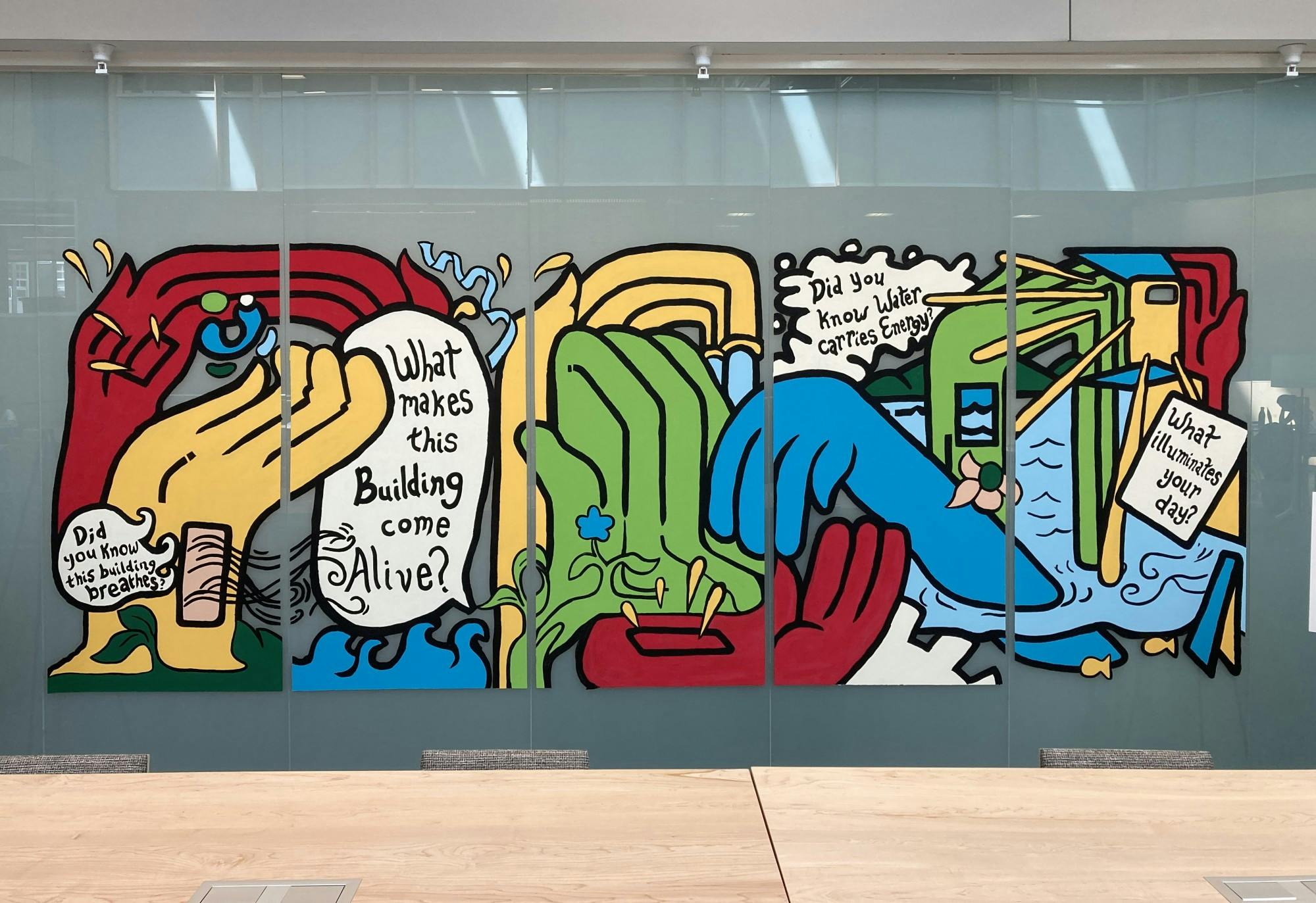In fall 2021, a team of students received a challenge: How could they make the energy efficiency of the Irving Institute for Energy and Society more visible to everyday visitors of the building? In response, the team commissioned a mural, which a group of student artists then conceptualized in the spring. The mural is now visible to the public in the atrium of the Irving Center.
“The Irving Institute is the most efficient building on campus; it’s got all these fun, cool new features that make it super amazing, but no one really would see that or really know if you just walked in the building on your own,” Avery Hormaechea ’24, one of the student commissioners, said.
Hormaechea is a member of Design Corps, a program within the Thayer School of Engineering’s Design Initiative at Dartmouth. The program matches teams of students interested in applying engineering and design thinking skills with on-campus clients. This particular team of students — composed of Hormaechea, Kiera Bernet ’23 and Sanne Schouten ’23 — was paired with the Irving Center and the Sustainability Office. Irving Institute academic director Amanda Graham and Dartmouth Sustainability director Rosi Kerr requested that the Design Corps team “showcase the efficiency of the Irving building,” according to Schouten.
Once the team had their assignment, they first conducted research to learn what the most interesting features of the building were and how to best communicate those to their audience, according to Hormaechea. The team spoke to people who work in the Irving Institute, students who frequent the building and various design professors before settling on the idea of a mural.
Their research also revealed four key elements of the Irving Institute that the team wanted to highlight in the mural, Hormaechea said. According to the mural’s curators’ statement, written by the the Design Corps Irving Institute and Sustainability Office team, the four features include the following: 91% of the Irving Institute’s workspaces are naturally lit; the glass facade pulls air up using fans — without expending energy — in order to operate as a natural ventilation system; the building’s heating and cooling system is water-based and the building regulates temperature and air flow using automation.
Once the Design Corps team settled on highlighting these four concepts in a mural, they commissioned student artists to actualize the project in the spring. The process of designing the mural took about one month and painting the mural took about one week, according to Hormaechea.
“There ended up being seven artists who went on to create the final design and then install it,” Hormaechea said. “They did all the actual creation of the design, and we just helped them along the process, giving feedback.”

Harrison Munden ’23, one of the artists, described the mural as featuring many “hands in motion.”
“We wanted to have it be free and flowy and sort of feel like it was a community — which is why we have all those hands working together [on the mural],” Munden said. “And they flow into the painting because we are the spaces that we create.”
Munden explained that the artists wanted the mural to be abstract in order to represent the creativity and “risk” that the Irving Institute embodies.
“I know that changing to a hot water heating system is a huge risk for Dartmouth because it requires all new pipes and a completely new heating system, but it’s more efficient in the future and can save a lot of money,” Munden said. “That sort of thinking is something that we wanted to keep in this painting, which is why we went this more abstract way instead of something more traditional.”
The final iteration of the mural includes many bright, contrasting colors. According to Munden, the artists chose to use bright colors in order to ensure that the mural would pop.
“The background that the mural was going on was going to be a frosted glass … so we chose brighter colors and we wanted it to catch your eyes,” Munden said.
According to Sam Miller ’24, another artist, the only challenge he encountered while painting the mural was the difficulty of working on a glass surface.
“It takes a lot of time painting on glass and getting layers of paint to show up and not translucent — to just be a solid color. It took a lot of coats, and it took a lot of time,” Miller said.
Hormaechea noted that she was grateful that the mural provided a unique space on campus to display student art.
“We also, through this research process, learned that there's just not a lot of spaces on campus for student artists to present their work and have it displayed … so it was really cool to … have an opportunity for [students] to share their work,” Hormaechea said.
The mural is a temporary fixture, according to Hormaechea. However, she noted that the Irving Institute and the Sustainability Office expressed some interest in continuing to hire students to design murals for the space. Miller shared strong support for this idea.
“I definitely think that this should keep going and they should keep hiring student artists to do this because it really makes the space feel more like it belongs to the students and the community,” Miller said.
Arielle Feuerstein ’24 is an English major from Bethesda, Maryland. She currently serves as the production executive editor, and in the past, she wrote and edited for Mirror. In addition to writing, Arielle enjoys crocheting, board games and walks around Occom Pond.




